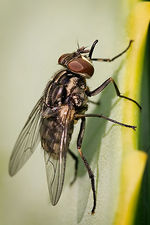Difference between revisions of "Stomoxys calcitrans"
| Line 9: | Line 9: | ||
|} | |} | ||
| − | ''S. calcitrans'' can feed on a number of hosts in close succession, and therefore can act as an important mechanical vector in the transmission of disease. | + | ''S. calcitrans'' can feed on a number of hosts in close succession, and therefore can act as an important mechanical vector in the transmission of disease e.g. [[Equine Infectious Anemia|Equine infectious anaemia]]. |
| + | |||
| + | ''S. calcitrans'' can also act as intermediate hosts of the nematode [[Parasitic skin infections - Pathology#Helminths|''Habronema'']]. | ||
==Identification== | ==Identification== | ||
| − | |||
''Stomoxys calcitrans'' has a high resemblance to [[Musca spp.|''Musca domestica'']]. | ''Stomoxys calcitrans'' has a high resemblance to [[Musca spp.|''Musca domestica'']]. | ||
''S. calcitrans'' is 5-7mm long, and both the males and females suck blood. They are grey with four long longitudinal stripes on the thorax, and with large black spots on the abdomen. | ''S. calcitrans'' is 5-7mm long, and both the males and females suck blood. They are grey with four long longitudinal stripes on the thorax, and with large black spots on the abdomen. | ||
The larvae are identified bu examination of the posterior spiracles. | The larvae are identified bu examination of the posterior spiracles. | ||
| + | |||
| + | Eggs are yellow, and approximately 1mm in length | ||
==Life cycle== | ==Life cycle== | ||
| − | + | Eggs are laid on manure, or rotting hay and straw. The eggs then develop into larvae in usually less than 4 days, and then transform from larvae into adults. The females require several large blood meals before they are successfully able to reproduce. | |
| − | |||
| − | |||
| − | |||
| − | |||
| − | |||
| − | |||
| − | |||
| − | |||
| − | |||
| − | |||
| − | |||
| − | |||
| − | |||
| − | |||
| − | |||
| − | + | The life cycle from the production of an egg to a fully mature adult can range from 12-60 days. | |
| − | + | Adult flies can survive for around 1 month. | |
[[Category:Biting_Flies]] | [[Category:Biting_Flies]] | ||
[[Category:To_Do_-_Max]] | [[Category:To_Do_-_Max]] | ||
Revision as of 17:59, 15 July 2010
Introduction
| Also known as: | Stable fly |
S. calcitrans can feed on a number of hosts in close succession, and therefore can act as an important mechanical vector in the transmission of disease e.g. Equine infectious anaemia.
S. calcitrans can also act as intermediate hosts of the nematode Habronema.
Identification
Stomoxys calcitrans has a high resemblance to Musca domestica. S. calcitrans is 5-7mm long, and both the males and females suck blood. They are grey with four long longitudinal stripes on the thorax, and with large black spots on the abdomen.
The larvae are identified bu examination of the posterior spiracles.
Eggs are yellow, and approximately 1mm in length
Life cycle
Eggs are laid on manure, or rotting hay and straw. The eggs then develop into larvae in usually less than 4 days, and then transform from larvae into adults. The females require several large blood meals before they are successfully able to reproduce.
The life cycle from the production of an egg to a fully mature adult can range from 12-60 days.
Adult flies can survive for around 1 month.
